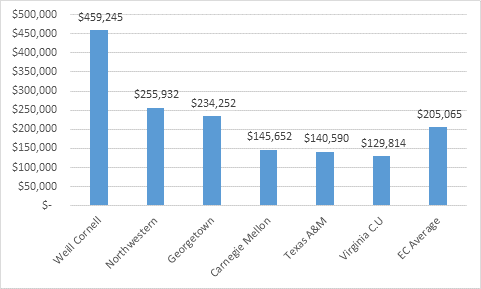The Washington Post had an absolutely fascinating article earlier this week regarding the sums that the Government of Qatar is paying various American universities to be part of its set up at Education City.
For those who are unfamiliar with Education City, a slight diversion. About 15 years ago the Qatari royal family got frustrated with the state of local education and hit on the idea of creating a world-class educational facility by inviting top US universities to come in and each run one faculty. So Virginia Commonwealth was invited to set up a visual arts school, Georgetown came in to run the school for the foreign service, Weill Cornell did the medical school, etc. (Northwestern, Carnegie Mellon, and Texas A&M also have campuses there).
Now this wasn’t your typical branch campus arrangement. These institutions were not over there to make money by offering degrees for high prices. Rather, the Qatari Royal Family was paying them big dollars to educate their students in situ (there’s a similar arrangement in place for the NYU and Sorbonne campuses in Abu Dhabi). The universities themselves had nothing at risk: each one received its own gorgeous building fully paid for by the Qataris.
But nobody knew exactly how much they were getting until the WaPo article this week. Using tax records, Department of Education data and freedom of information requests, the paper managed to lift the veil on the financial arrangements. As it turns out, the Qataris are paying them, collectively, just under $405 million per year to operate their Doha campuses. Weill Cornell rakes in the most (hey it’s a medical school) at $121.7 million, and Virginia Commonwealth the least at $41.8 million.
On their own, these are eye-watering figures. But to truly get a sense of how insane this is, you have to look at what this translates to in per-student terms. These are actually pretty small operations – according to the data I was able to piece together the six campuses collectively only educate about 2000 students. So the actual expenditure per student is actually just over $205,000.
Qatari Government Expenditure per Student, Education City Campuses

In other words, these schools are making out like absolute bandits. Free buildings, six figure per student incomes – this is heaven. But the question really is what on earth possessed the Qataris to pay this kind of price?
It’s instructive here to look at what the Qataris are paying the College of the North Atlantic to run their community college a few kilometers away from Education City. It’s the same deal – Qataris built the campus and pay an annual fee to CONA to run the place. Details on the post-2013 CONA contract are scarce, but the first ten-year contract was worth $500 million so let’s just say it’s worth $50 million/year (the CONA Annual report gives figures in the $10-11M range, but I’m fairly sure that’s profit not operating). But CONA educates more students than all the Education City campuses combined: with roughly 3000 in total – I make that out to be $16,500 or so per year – or about an eighth of what the cheapest institute at Education City is getting.
Now obviously, that’s not a bad deal for CONA (In comparison, the college receives about $84 mil in provincial grant in aid and tuition to educate its 8888 students in regular programming back in Newfoundland, which comes to about $9400/student), and obviously there are some differences in delivery costs for college and university programs, but they aren’t that big. Georgetown’s campus is a pure social sciences operation, and at Canadian universities those rarely cost more than $15,000/student. So where’s that extra money going?
Well, to student amenities, partly. These places are like little educational wonderlands(check out Georgetown’s student life page). But mostly, this is pure rent. Unlike CONA, these American institutions have global prestige. And that in a nutshell is what the Qataris are paying hundreds of millions a year for – the right to be associated with these institutions’ prestige.
That’s what brand is all about. And apparently, it’s worth up to a couple of hundred thousand dollars per student. Nice work if you can get it.

 Tweet this post
Tweet this post
